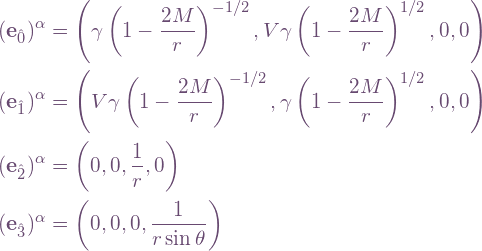Suppose an observer u moves radially with speed (3-velocity) ![]() relative to “stationary” Schwarzschild observers, where we define
relative to “stationary” Schwarzschild observers, where we define ![]() as inward motion. Then one natural choice of orthonormal tetrad is:
as inward motion. Then one natural choice of orthonormal tetrad is:

where the components are given in Schwarzschild coordinates. This may be derived as follows.
The Schwarzschild observer has 4-velocity
![Rendered by QuickLaTeX.com \[\fvec u_{\rm obs}=\left(\Schw^{-1/2},0,0,0\right)\]](http://cmaclaurin.com/cosmos/wp-content/ql-cache/quicklatex.com-492ec50d4e2d8170e1f27d344d1d02ba_l3.png)
because the spatial coordinates are fixed, and the t-component follows from normalisation ![]() (Hartle
(Hartle  §9.2).
§9.2).
Now the Lorentz factor for the relative speed satisfies ![]() , and together with normalisation
, and together with normalisation ![]() and the assumption that the θ and φ components are zero, this yields
and the assumption that the θ and φ components are zero, this yields ![]() given above.
given above.
We obtain ![]() by orthonormality:
by orthonormality: ![]() and
and ![]() , and again making the assumption the θ and φ components are zero. Note the negative of the r-component is probably an equally natural choice. Then
, and again making the assumption the θ and φ components are zero. Note the negative of the r-component is probably an equally natural choice. Then ![]() and
and ![]() follow from simply normalising the coordinate vectors.
follow from simply normalising the coordinate vectors.
Strictly speaking this setup only applies for ![]() , because stationary timelike observers cannot exist inside a black hole event horizon! Yet remarkably the formulae can work out anyway (MTW
, because stationary timelike observers cannot exist inside a black hole event horizon! Yet remarkably the formulae can work out anyway (MTW  …) . An alternate approach is local Lorentz boost described shortly.
…) . An alternate approach is local Lorentz boost described shortly.
Hartle  … Also check no “twisting” etc…
… Also check no “twisting” etc…